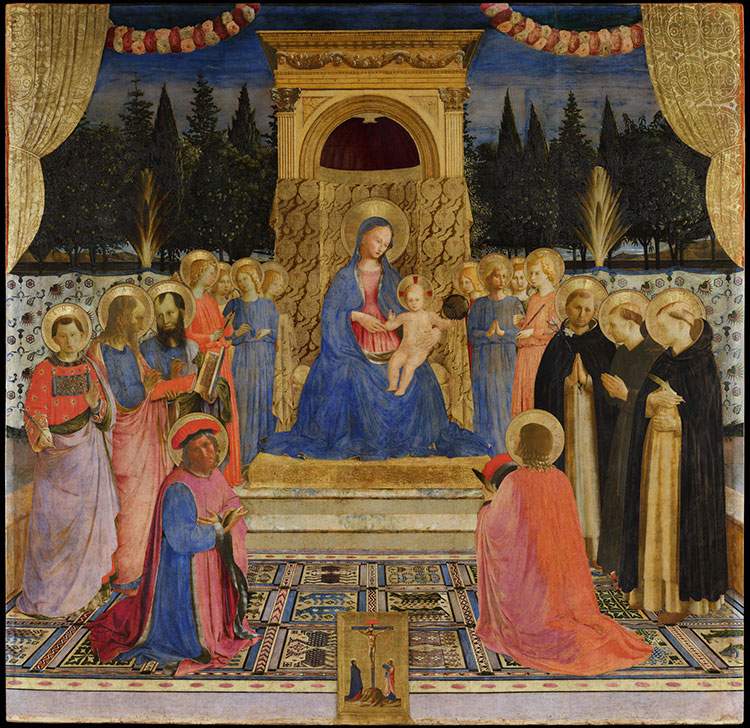After restoration, the San Marco Altarpiece, a masterpiece by Beato Angelico, returns to the Museo di San Marco in Florence.
Commissioned by Cosimo and Lorenzo de’ Medici for the high altar of the church of San Marco, dedicated to St. Mark and Saints Cosmas and Damian, the altarpiece was made between 1438 and 1443. It was only Cosimo, however, who saw it finished before the Epiphany of 1443, since Lorenzo died on September 23, 1440, and traces of this remain in the very attitude of the two patron saints: while Cosmas looks at the viewer, inviting him with the gesture of his hand to devoutly admire the scene, Damian is on his back, prostrate to invoke divine mercy and Mary’s intercession.
The intent of the commissioners was to show the Medici’s commitment to the church and convent of St. Mark’s: it was a complex wooden machine that stood on the altar about three and a half meters high and consisted of at least twenty-six paintings, including pillar saints, predella compartments and the central altarpiece. Today only eighteen remain, preserved in nine different museums.
The square central panel was set between pillars decorated with tablets with saints, solidly implanted on the stepped predella, with eight stories of Saints Cosmas and Damian. The central panel depicts a Sacred Conversation, at the center of which is the Madonna and Child enthroned among eight angels and eight saints. In front of the throne, the angels and saints are divided into two groups: from the left, St. Lawrence, who greets the worshipper approaching the altar with his hand raised, (he is the protector of Lorenzo, Cosimo’s brother), St. John the Evangelist (protector of Giovanni di Bicci, Cosimo’s father), St. Mark, to whom the church is dedicated, who shows his gospel to John. On the other side of the throne is St. Dominic, the founder of the Order, looking at Francis of Assisi, who in turn, along with St. Peter the Martyr, addresses the Virgin and Child. The predella narrates the lives of Saints Cosmas and Damian. The Museum of St. Mark preserves only two compartments of the eight that made up the predella.
Possible reconstructions of the final appearance of the complex machine are numerous and often reliable, so it is difficult to imagine with certainty the overall appearance of the work.
The restoration was carried out by theOpificio delle Pietre Dure and was directed by Marco Ciatti and Cecilia Frosinini; it was carried out by Caterina Toso and a group, composed of Andrea Santacesaria, Ciro Castelli, Alberto Dimuccio and Luciano Ricciardi, for the wooden support. Diagnostic investigations were carried out by OPD Scientific Laboratory, CNR-Ino (National Institute of Optics), ENEA (National Agency for New Technologies, Energy and Sustainable Economic Development), Rome section, La Casaccia; and INFN (National Institute of Nuclear Physics), Florence section and University of Florence, Department of Physics.
A cleaning operation was found to be necessary to recover the original material concealed by the storage material of previous restorations.During the restoration, distorted volumes were discovered and a new balance was sought to harmonize what remains of an altarpiece by Beato Angelico.
“With the return of the San Marco Altarpiece to the Sala dell’Ospizio, there is a complete reconstitution in the Museo di San Marco of that unique ensemble of works on panel by Beato Angelico that, together with his frescoes painted for the Dominican convent, and in particular those celebrated in the cells, makes this museum among the most fascinating and beloved in Florence. The San Marco Altarpiece is a founding text of Florentine Renaissance painting. The splendid restoration carried out by the Opificio delle Pietre Dure has restored its spatial values and the splendor of the pictorial surfaces and the marvelous gilding to the highest possible level, considering the severe damage it suffered in the past. A return that contributes in a special way to the celebrations of the 150th anniversary of the founding of the Museum,” said the director of the Polo Museale della Toscana, Stefano Casciu.
“The restoration of the St. Mark’s Altarpiece was a complex challenge because of the seriousness of the conservation problems present both in the wooden support and on the pictorial surface. It was therefore approached and solved as a research project with innovative solutions for both aspects, so as to allow us to achieve not only the restoration of the work, but also to have developed new methods of intervention. According to the OPD’s own desire for dissemination, a volume of studies in our series is planned to be released next spring,” added OPD Superintendent Marco Ciatti.
 |
| Beato Angelico's St. Mark's Altarpiece returns after restoration to St. Mark's Museum |
Warning: the translation into English of the original Italian article was created using automatic tools. We undertake to review all articles, but we do not guarantee the total absence of inaccuracies in the translation due to the program. You can find the original by clicking on the ITA button. If you find any mistake,please contact us.